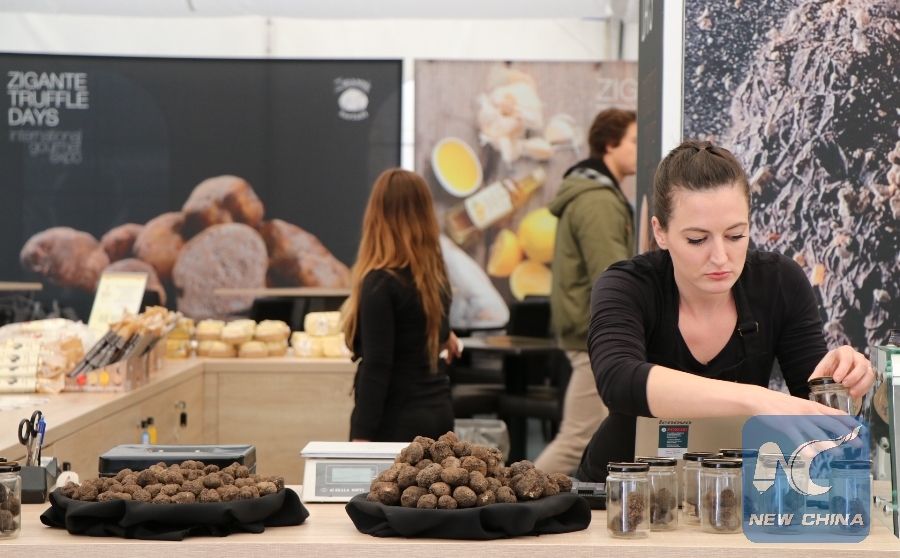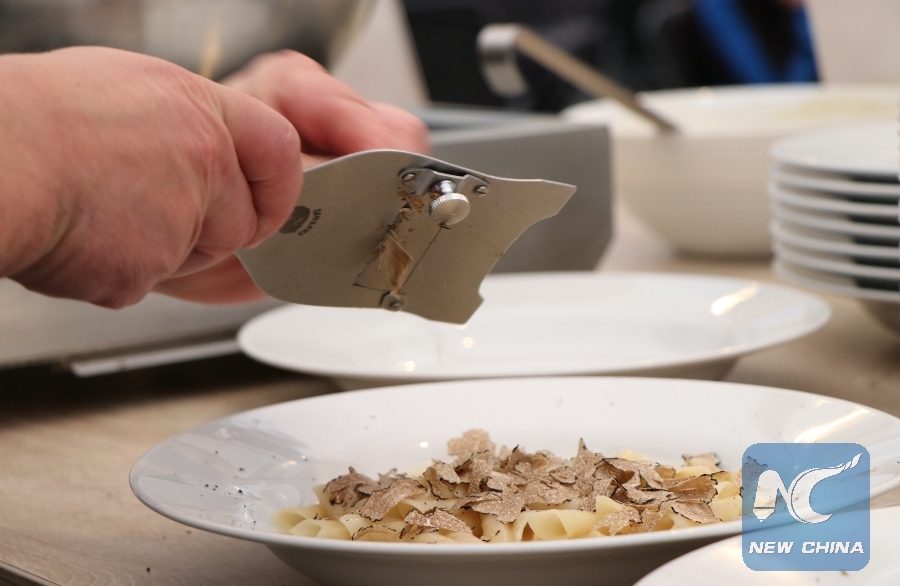
A lady sells truffles during Zigante Truffle Days in Livade, Croatia, on Nov. 5, 2017. (Xinhua/Relja Dusek)
by Relja Dusek
ZAGREB, Nov. 10 (Xinhua) -- In the center of the Istrian peninsula, there is a forest known for "black diamonds" that make this region the truffle capital of the world.
The unique fragrance of the "royal mushroom" was known to the Mesopotamian rulers 4,000 years ago. It was enjoyed by ancient Greeks and Roman emperors and today, truffles are still among the most highly-prized gourmet specialties.
Known to the French as the "black diamonds of gastronomy", Truffles grow under the ground in symbioses with tree roots, and are therefore very difficult to find. They are rare and grow only in a few locations in Europe, in some parts of Italy, France, Spain and Croatia.
Istria, a heart-shaped peninsula whose biggest portion is within Croatian territory, is home to white and black truffles.
In late autumn, at the top season of the white truffles, Istrian forests are full of trained dogs running, sniffing and searching for the rare mushroom. While truffle hunters try to catch them, especially when the dogs excitedly start to dig into the earth. It is a sign that they smell truffles, and it is the moment when the hunters take over the job with a dagger-shaped trowel until the truffles are dug out.
Ivica Kalcic has been a truffle hunter for almost 15 years. He has two English cocker spaniels that help him in the hunt. The older one is trained and always successfully in finding truffles. The younger one, this is just the first semester of school.
One day it should be as useful as the mother. "We always go in the hunt with dogs. One is sniffing and searching for truffles, while the other is here to learn the process," Kalcic told Xinhua.
In olden days, pigs and not dogs were used for truffle hunting. But this tradition is now dead since pigs like truffles so much that they usually eat them on the spot.
"Pigs are dangerous animals and it's hard to control them. When they start digging for a truffle, you have to react very quickly because a pig would destroy or eat truffle. And it is not easy to fight with a pig for a truffle. Once, my friend almost lost his finger," Kalcic said.
During truffle season, Kalcic takes visitors to the forest to demonstrate a truffle hunt. It is one of the most attractive tourist attractions in central Istria.

A chef slices truffles on a plate of pasta during Zigante Truffle Days in Livade, Croatia on Nov. 5, 2017. (Xinhua/Relja Dusek)
Visitors around the world come here to experience a truffle hunt and then taste these gourmet specialties. It is an organized and well-directed attraction where hunters hide truffles under the ground beforehand for the dogs. And in just 20 minutes, dogs bark and dig when they find a white truffle.
"The best time for the search is at night when the air is cleaner, so dogs can smell a truffle more easily. The downside is that dogs easily get lost in the dark," Kalcic said.
On Nov. 2, 1999, the biggest white truffle in the world was found in this forest. The lucky finder was Giancarlo Zigante. With the help of his German pointer Diana, he found a tuber weighing 1.31 kg in the Motovun forest near Livade.
It was, and still is, the biggest white truffle in the world, a mushroom that earned its spot in the Guinness Book of World Records.
It was a breakthrough for Zigante whose name became a synonym for the Istrian truffle. Today, he runs a famous truffle restaurant in Livade and organizes Zigante Truffle Days, a 10-weekend long festival of truffles.
"People around the world come here in Livade to taste the best truffles. Istria is best known for white truffles. They are the most expensive truffles in the world. Unlike black truffles that can be dried, frozen and preserved, white truffles are special because they cannot be conserved. You have to eat them in a week," Morena Borovecki, marketing manager of the Restaurant Zigante and Zigante Truffle Days, told Xinhua.
The price, she said, varies from season to season. "It all depends on the offer. This season, the price of a white truffle can reach 5,000 euros (5,835 U.S. dollars) per kilo."
Nevertheless, the visitors of the festival don't ask for the price. Thousands of them come each year to enjoy this noble mushroom.
"The best way to consume truffles is to slice fresh truffles directly on the food. It could be a pasta, potatoes or eggs because these groceries are neutral and then you can feel better the taste and flavor of truffle," Borovocki explained.
Livade is not the only Istrian village that celebrates truffles. In October and November, there are exhibitions and fares throughout the peninsula. Istria even has "the city of truffles" named Buzet.
Beautiful nature and delicious food has transformed the inner part of the Istria region that is often described as "the new Tuscany".

